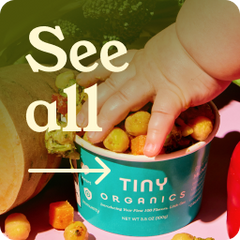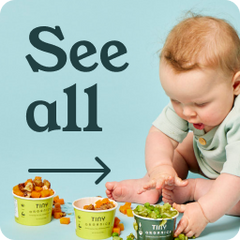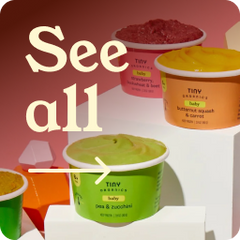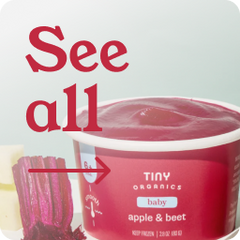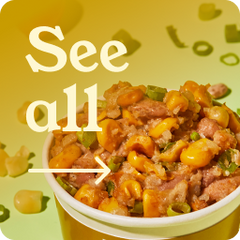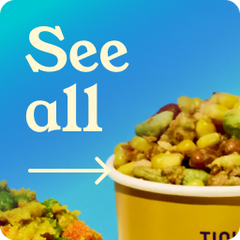Tiny Feeding Guide: 8 - 12 Months

- It's all about the mighty pincer grasp! (The ability to to pick up smaller objects, like pieces of food, between her thumb and forefinger.)
- Don't be concerned if your little one is more interested in playing with his food than eating it.
- Teething is at its height, he's gumming everything and drooling a lot.
- Now is a good time to introduce different textures (not just super soft veggies and fruits), like crunchy and al dente. Have your baby test the new texture and follow her cues.
Development at this age...
By 8-12 months, your little one has begun to master her pincer grasp, the ability to grasp a small object with her thumb and forefinger. This is a crucial step in her ability to feed herself. As with any learning endeavor, mastery can take a while, and whatever she's picking up may be more interesting to her than actually eating it. So don’t become discouraged or frustrated by smashed or smeared food as your baby attempts to feed (or entertain!) herself.
Depending on your approach, whether you do (chunky) purees or (soft) finger foods/baby-led weaning or a combination, focus on at least some food getting to your baby’s mouth for practice gumming and swallowing! It’s perfectly fine to continue offering to spoon feed your little one, but don’t be surprised if he exerts a sudden desire for independence—grabbing for the utensil or bypassing it all together in favor of his fingers!
Babies develop at different rates. Age isn’t always an indicator of readiness for finger foods, but you’ll know your little one is ready for a variety when she can:
- Sit up independently and has complete head and neck control
- Brings her hands and toys to her mouth
- Lean forward in the highchair and shows interest in food
How much?
Your baby’s portions will continue to increase, but he still doesn't need a lot of food. Continue to offer 24 to 40 ounces of breast milk or formula per day, as up until 12 months they continue to be necessary for your little one's nutritional needs. You can offer 1 ounce- ½ cup (or more, depending on his appetite) of solid foods at each meal. As long as you're continuing to provide food and your baby doesn't seem hungry, he's eating the right amount of food for him.
Again, don't be concerned if your little one is more interested in playing with his food than eating it. Breastmilk or formula is still the primary form of nutrition. Food provides a tactile learning experience that is equal parts function and fun. Lay something under the high chair that you can throw in the washing machine, and let your baby go to town. Stressing about the mess is likely to make the experience less pleasurable for your baby and enjoying the meal experience is key to developing a healthy relationship with food.
Good foods for this age
Offer a variety of textures and tastes that increase the flavor palate and that baby can practice picking up.
Good foods for this age:
- Steamed, cooked veggies (try crunchier textures too!): carrots, zucchini, sweet potato, yam, root vegetables (parsnips, carrots, turnips), spinach, kale, swiss chard, green beans, butternut/summer squash, winter squash, broccoli, cauliflower, peas, asparagus, beets, bell peppers
- Fruits: avocado, banana, apple, pear, pumpkin, raspberries, peaches, nectarines, plums, apricots, cherries, prunes, figs, dates, cranberries, mango, papaya, melon
- Grains/Beans: chickpeas, black beans, edamame (*contains soy), fava beans, black-eyed peas, lentils, kidney beans, oatmeal, couscous, quinoa
- Pasta: Orzo, elbow, rotini, preferably wholegrain










